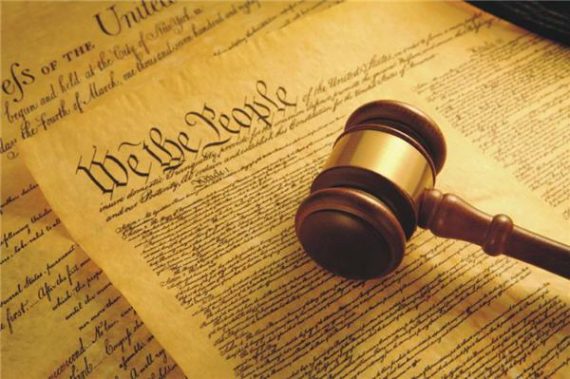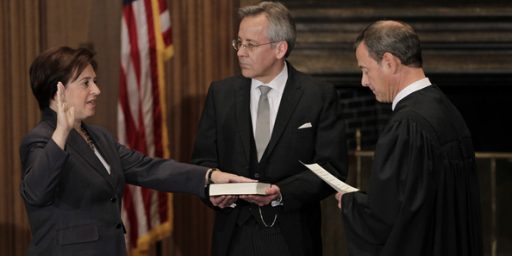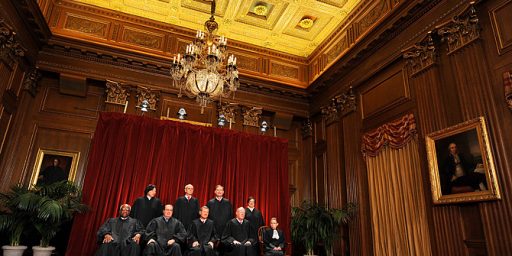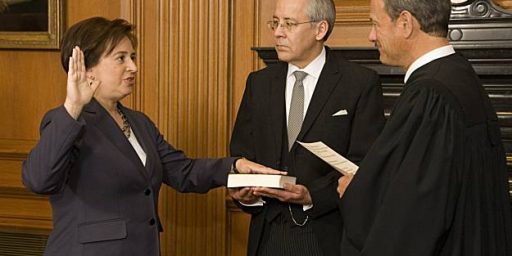Supreme Court Backup Plan?
Pat Leahy suggests allowing retired SCOTUS Justices fill in when a sitting member recuses himself. A great idea on paper, it won't work in practice.
Apparently, there’s a growing problem with Supreme Court Justices forced to recuse themselves from cases and thereby leaving the possibility of tie decisions. A novel solution:
Senate Judiciary Committee Chairman Patrick J. Leahy (D-Vt.) is pondering whether a change is needed. He’s considering legislation that would allow a retired member of the Supreme Court to replace a justice who has recused himself — or herself — in a particular case.
This would avoid the court potentially splitting 4 to 4 on a case and, Leahy hopes, encourage justices to recuse themselves more often when there is an appearance of partiality.
“The highest court in the land is the final word on constitutional law,” Leahy said in a statement to The Washington Post. (Leahy first discussed the idea this summer with the National Law Journal.) “I want justices to feel free to recuse themselves when they have a conflict in a specific case.”
Justices recuse themselves occasionally from cases. The choice is theirs and they rarely explain the reason. Most often it is because of a financial conflict or the involvement of a family member. As the court has changed recently — with four new members in five years — the reason for recusal is increasingly because a justice played a role in the case in the lower courts.
Chief Justice John G. Roberts Jr. and Justices Samuel A. Alito Jr. and Sonia Sotomayor were all previously appeals court judges, and all have had to sit out cases that landed in the high court. In her first term, which concluded in June, Sotomayor recused herself from six cases, for instance, and did not take part in a greater number that the court was considering whether to review.
Elena Kagan, the newest justice, will be absent from the court’s mahogany bench for more than that. She already has identified a dozen cases she worked on as solicitor general that she will not hear as a justice, and more are likely as the court accepts new cases for the term that begins in October.
On its surface, this is a no-brainer. Retired justices still draw their full salary and occasionally fill in for judges on lower courts. (Sandra Day O’Connor has apparently been doing with some frequency.)
But, since so many cases are decided narrowly, replacing, say, a liberal judge with a conservative one or vice-versa would be problematic, to say the least.
That is complicated as well. If a lower court wants a retired justice to sit in on a case, it asks the chief justice to make the assignment. But at the high court, allowing the chief justice to choose from the retired justices could, in effect, be giving him two votes. An alternative would be to allow the justices to vote on the replacement. But should the recused justice have a say? Should there be a rotation?
And, at some point, theory steps aside and reality sets in. “It’s an interesting idea,” said James Sample, a Hofstra law professor who has specialized in studying judicial recusals. “The challenge is that it’s so difficult to divorce discussion of the proposal from the individual justices who might end up replacing the recused justices.”
In other words, the bench currently consists of Stevens, O’Connor and retired justice David H. Souter, all of whom are to the left of the court’s dominant conservatives.
It is as unlikely to think Republicans would think it is a good idea to put them back in the lineup, Sample said, as it is to think Leahy would be as keen on the idea if the available replacements were, say, former chief justices William H. Rehnquist or Warren E. Burger.
I like the notion of the recused Justice picking his fill-in, which would provide the best ideological and temperamental match. But with three moderate-to-leftist Justices constituting the entire roster of backups, it’s an idea whose time hasn’t arrived.







Another good advantage of this idea is that it would encourage justices to retire a bit earlier. If they still had the chance to sit in on a case now and then, there’s less down side and more up side to retirement. I’m a fan of judicial appointment for life, but one of the significant disadvantages of it is that we’ve had a few justices in recent memory who have held on until the bitter end, when it arguably would’ve been better for the nation if they’d retired a year or two earlier.
It’s by no means perfect in that regard, but I think it would be at least a small improvement there.
A shadow Supreme Court? Wouldn’t that require a constitutional amendment?
I can think of a half dozen other solutions more consistent with U. S. practice than that. For example, why not amend the Constitution to provide for alternates?
Or the Congress could even act to limit the appellate jurisdiction of the Supreme Court which would serve to reduce the Court’s workload and make recusal a less pressing matter.
As theory it’s a decent enough idea. But it’s really a solution in search of a problem. This issue simply isn’t common enough to be a real concern. Plus, any issue that can’t command 5 votes on one side without the full bench probably needs to simmer a while longer.
Currently, ties at the SCOTUS mean that the Court of Appeals decision is affirmed without precedent. I think allowing the three or more members of the Courts of Appeal to essentially decide a tie is superior to the types of doubtful machinations that emphasize that the justices have predilections.
Exactly, PD.
This idea of a reserve bench of retired Justices that could step in when a Justice has to recuse themselves would be more viable, I think, if it weren’t for life tenure and the fact that Justices typically retire when they’re old and ill. All three retired Justices seem healthy enough right now, but that hasn’t always been the case.
Here’s another idea — pick a reserve Justice from among the Chief Judges of the Courts of Appeal (except, of course, the particular Court of Appeal that a case may have come from). Many of those Judges have been on the bench longer than some members of the Supreme Court